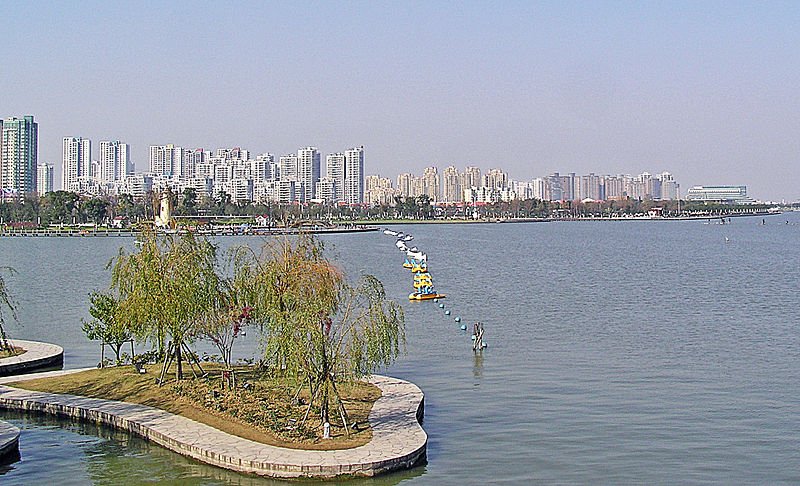 Jin Ji Lake in Suzhou
Jin Ji Lake in SuzhouSource: https://commons.wikimedia.org/wiki/File:Suzhou_Industrial_Park_%28SIP%29_-_West_Bank_of_Jin_Ji_Lake.jpg
Author: Donaldytong

Suzhou is a city in Jiangsu Province on the shores of Lake Taihu, near the mouth of the Yangtze River in China. It is a heritage-rich city famous for its canals, stone bridges, pagodas and Chinese gardens.
The modern urban center of Suzhou has a population of 2.4 million people as of 2008 within a prefecture-level city boundary with 6.3 million inhabitants.
Suzhou is one of the oldest cities in the Yangtze Basin. The area surrounding the city has been settled as early as 2,500 years ago, during the late Shang Dynasty. The city was founded by King Helu of the State of Wu in 514 BC, and was known as the Great City of Helu.
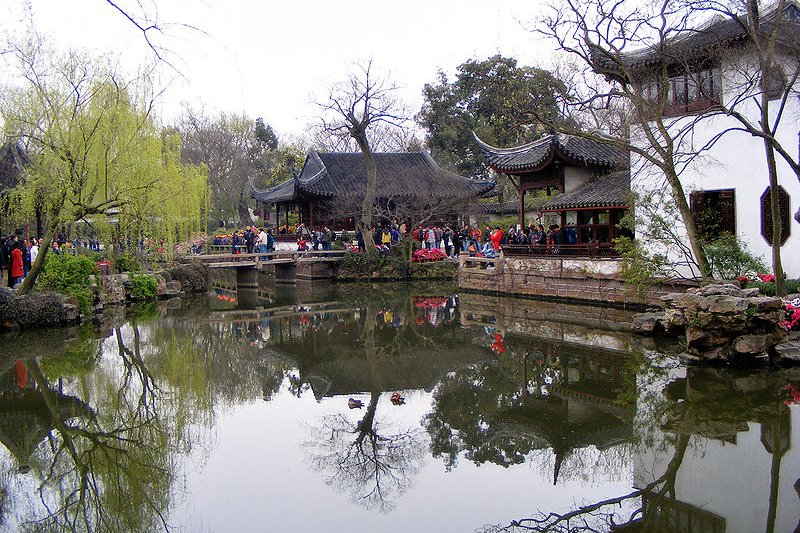 Humble Administrators Garden
Humble Administrators Garden
Author: Donaldytong

Suzhou is a city in Jiangsu Province on the shores of Lake Taihu, near the mouth of the Yangtze River in China. It is a heritage-rich city famous for its canals, stone bridges, pagodas and Chinese gardens.
The modern urban center of Suzhou has a population of 2.4 million people as of 2008 within a prefecture-level city boundary with 6.3 million inhabitants.
Suzhou is one of the oldest cities in the Yangtze Basin. The area surrounding the city has been settled as early as 2,500 years ago, during the late Shang Dynasty. The city was founded by King Helu of the State of Wu in 514 BC, and was known as the Great City of Helu.
 Humble Administrators Garden
Humble Administrators GardenSource: https://commons.wikimedia.org/wiki/File:Suzhou_-_humble_administrators_garden_-_overcast.jpg
Author: Peripitus

The State of Wu was vanquished by the State of Yue in 473 BC, and it in turn was vanquished by the State of Chu in 306 BC. With the fall of the State of Yue, so too the fortune of ancient Suzhou, with all that remains of that era being remnants of very old city walls and an ancient gate.
During the Qin Dynasty, Suzhou was known as Wu County. The overthrow of the Qin Dynasty took place in Suzhou in 209 BC.
Suzhou got its present name in AD 589, during the Sui Dynasty. It was during this period that the Grand Canal was completed, linking Beijing to Hangzhou, over a distance of 1,776 kilometers (1,103 miles). As Suzhou happened to be on the route of the canal, it benefitted greatly from the resulting commerce that passed through.
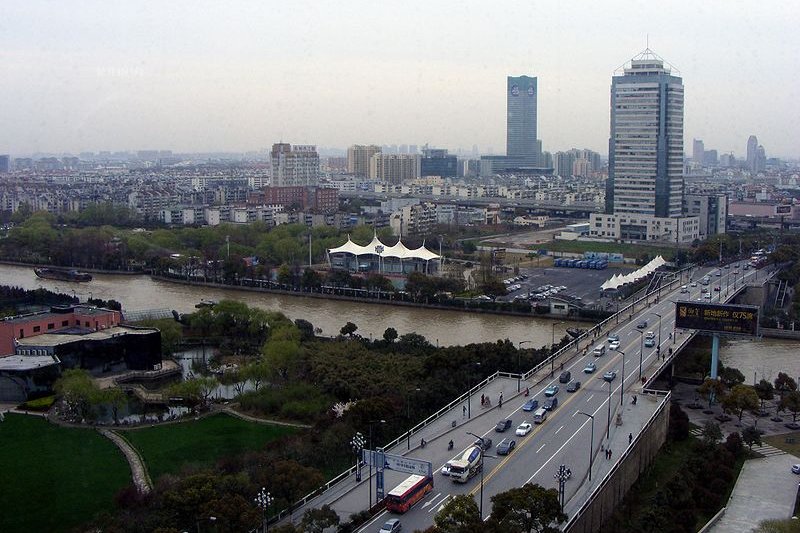 Suzhou, Jiangsu Province
Suzhou, Jiangsu Province
Author: Peripitus

The State of Wu was vanquished by the State of Yue in 473 BC, and it in turn was vanquished by the State of Chu in 306 BC. With the fall of the State of Yue, so too the fortune of ancient Suzhou, with all that remains of that era being remnants of very old city walls and an ancient gate.
During the Qin Dynasty, Suzhou was known as Wu County. The overthrow of the Qin Dynasty took place in Suzhou in 209 BC.
Suzhou got its present name in AD 589, during the Sui Dynasty. It was during this period that the Grand Canal was completed, linking Beijing to Hangzhou, over a distance of 1,776 kilometers (1,103 miles). As Suzhou happened to be on the route of the canal, it benefitted greatly from the resulting commerce that passed through.
 Suzhou, Jiangsu Province
Suzhou, Jiangsu ProvinceSource: https://commons.wikimedia.org/wiki/File:Overcast_Suzhou_March_2009.JPG
Author: Peripitus

The Shantung Canal was constructed in AD 825, during the Tang Dynasty, to link Suzhou to Huqiu. Then in AD 1035, the Temple of Confucius was built. The prosperity came to an abrupt end when in 1130, the Jinn Army (ancestors of the Manchus) ransacked Suzhou. This was followed by the Mongol invasion of 1275.
Within a century, Suzhou bounced back, becoming in 1356 the capital of rebel Zhang Shicheng in the fight against the Mongols. Zhang's rival Zhu Yuanzhang, who eventually ascended the throne as the Hongwu Emperor, first emperor of the Ming Dynasty, attacked and destroyed Zhang's stronghold, the walled city of ancient Suzhou. He then imposed heavy taxes on its inhabitants.
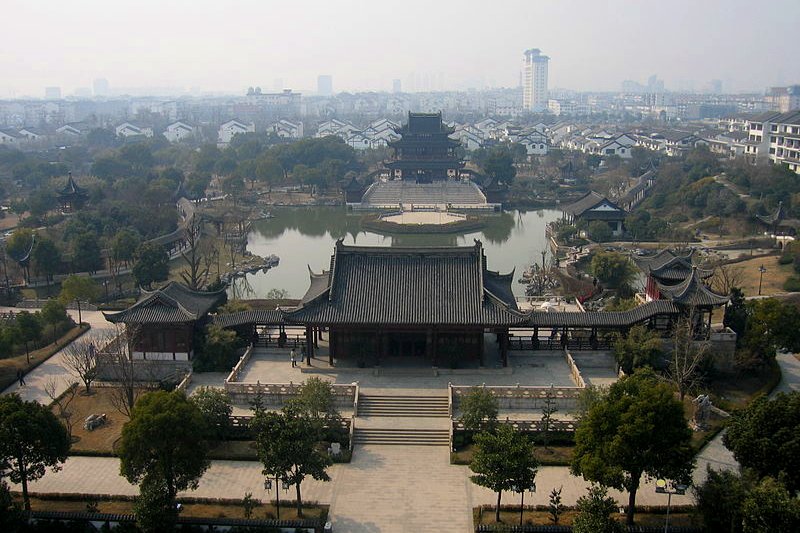 Panmen Scenic Area, Suzhou
Panmen Scenic Area, Suzhou
Author: Peripitus

The Shantung Canal was constructed in AD 825, during the Tang Dynasty, to link Suzhou to Huqiu. Then in AD 1035, the Temple of Confucius was built. The prosperity came to an abrupt end when in 1130, the Jinn Army (ancestors of the Manchus) ransacked Suzhou. This was followed by the Mongol invasion of 1275.
Within a century, Suzhou bounced back, becoming in 1356 the capital of rebel Zhang Shicheng in the fight against the Mongols. Zhang's rival Zhu Yuanzhang, who eventually ascended the throne as the Hongwu Emperor, first emperor of the Ming Dynasty, attacked and destroyed Zhang's stronghold, the walled city of ancient Suzhou. He then imposed heavy taxes on its inhabitants.
 Panmen Scenic Area, Suzhou
Panmen Scenic Area, SuzhouSource: https://commons.wikimedia.org/wiki/File:Panmen_Scenic_Area_1.jpg
Author: Chinatravelsavvy

Despite the heavy taxes imposed by the Nanjing-based Ming government, Suzhou began to prosper. This is reflected in the many Chinese gardens that were constructed during this period and the subsequent Qing Dynasty.
The Japanese Occupation of World War II laid waste many of Suzhou's fabulous gardens. They were only restored in the 1950's.
Suzhou's cultural and historical heritage were recognised when the government of China listed it as one of the four ancient cities of China, together with Beijing, Hangzhou and Guilin.
Suzhou is today celebrated for its classical Chinese gardens. The Classical Gardens of Suzhou was inscribed as a World Heritage Site in 1997.
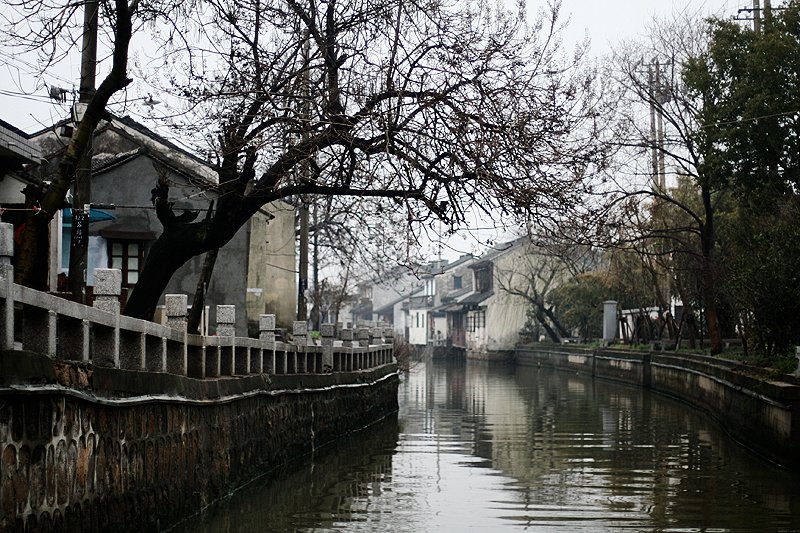 Suzhou Canal
Suzhou Canal
Author: Chinatravelsavvy

Despite the heavy taxes imposed by the Nanjing-based Ming government, Suzhou began to prosper. This is reflected in the many Chinese gardens that were constructed during this period and the subsequent Qing Dynasty.
The Japanese Occupation of World War II laid waste many of Suzhou's fabulous gardens. They were only restored in the 1950's.
Suzhou's cultural and historical heritage were recognised when the government of China listed it as one of the four ancient cities of China, together with Beijing, Hangzhou and Guilin.
Suzhou is today celebrated for its classical Chinese gardens. The Classical Gardens of Suzhou was inscribed as a World Heritage Site in 1997.
 Suzhou Canal
Suzhou CanalSource: https://commons.wikimedia.org/wiki/File:Suzhoupic12.jpg
Author: d'n'c

The most convenient way to reach Suzhou is via Shanghai. Although it has its own airport, the number of flights going to Suzhou is quite limited.
If you are arriving by flight from Shanghai Pudong International Airport, you can take a shuttle bus to Suzhou. The fare is ¥82. There are also shuttle buses from Shanghai Hongqiao Airport for ¥50.
By Train
Suzhou is on the route of the Shanghai-Beijing railroad. There are frequent high-speed D-trains from Nanjing (¥67, 1 hour 40 minutes) and Shanghai (¥26, 40 minutes), as well as from Hangzhou, Hefei, Beijing and Wuhan. The Suzhou Railway Station is on the north side of the city.
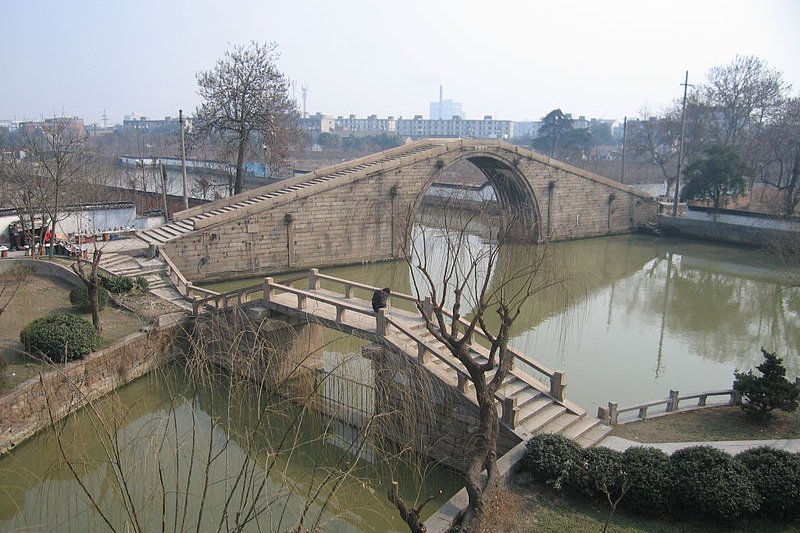 Panmen Water Gate, Suzhou
Panmen Water Gate, Suzhou
Author: d'n'c

Travel to Suzhou
By PlaneThe most convenient way to reach Suzhou is via Shanghai. Although it has its own airport, the number of flights going to Suzhou is quite limited.
If you are arriving by flight from Shanghai Pudong International Airport, you can take a shuttle bus to Suzhou. The fare is ¥82. There are also shuttle buses from Shanghai Hongqiao Airport for ¥50.
By Train
Suzhou is on the route of the Shanghai-Beijing railroad. There are frequent high-speed D-trains from Nanjing (¥67, 1 hour 40 minutes) and Shanghai (¥26, 40 minutes), as well as from Hangzhou, Hefei, Beijing and Wuhan. The Suzhou Railway Station is on the north side of the city.
 Panmen Water Gate, Suzhou
Panmen Water Gate, SuzhouSource: https://commons.wikimedia.org/wiki/File:Panmen_2.jpg
Author: Chinatravelsavvy

Looking for information on Penang? Use this Map of Roads in Penang to zoom in on information about Penang, brought to you road by road.

Author: Chinatravelsavvy

Budget Travel within Suzhou
Probably the best way to explore Suzhou is to go on foot. When the distances are too far, you can hail a taxi. The fare starts at ¥10 for the first 3 kilometers, and thereafter ¥2.50 for every subsequent kilometer. The taxi drivers in Suzhou are rather poor in their local knowledge, so it helps to get your destination written down in Chinese.Classical Gardens of Suzhou
- Humble Administrator's Garden (Zhuo Zheng Yuan)
The biggest and finest classical Chinese garden in Suzhou. - Garden of the Master of Nets (Wang Shi Yuan)
The smallest but said to be the most beautiful and well-proportioned classical Chinese garden in Suzhou. - Lingering Garden (Liu Yuan)
One of the biggest and important classical Chinese garden in Suzhou. - West Garden (Xi Yuan)
A Buddhist temple in a garden setting. - Lion Forest Garden (Shi Zi Lin)
One of the four great classical Chinese gardens of Suzhou. - Garden of Cultivation (Yi Pu Garden)
Another beautiful garden in Suzhou. - Mountain Villa with Embracing Beauty (Huanxiu Shanzhuang)
One of the beautiful rock-and-water gardens in Suzhou. - Surging Wave Pavilion Garden (Canglang Ting)
One of the oldest of Suzhou's private gardens. - Couple's Garden Retreat (Ou Yuan)
Garden with rockeries, pool and open pavilion. - Retreat and Reflection Garden (Tui Si Yuan)
A garden located in the town of Tongli, 30 km from Suzhou. - Tarrying Garden (Wufeng Xianguan)
Garden outside Changmen Gate. - Garden of Pleasure (Yi Yuan)
Very small garden in the heart of downtown Suzhou. - Former Residence of Yu Yue
The unpretentious abode of poet scholar Yu Yue. - Pan Men Scenic Area
An area in Suzhou with many historical sights.
Nature Sights
- Huqiu Shan (Tiger Hill)
Hill on the northwest of Suzhou, burial place of Helu, the King of Wu, founder of Suzhou.
Temples in Suzhou - Beisi Ta (North Pagoda)
A towering 76-meter pagoda which is one of the big tourist attractions of Suzhou. - Confucius Temple
Temple established in the Song Dynasty. - Hanshan Si (Cold Mountain Temple)
Temple close to the Grand Canal. - Huqiu Tower
One of the few remaining pagodas of its type, first built in the Song Dynasty. - Shuang Ta (Twin Pagoda)
A pair of 30-meter-tall pagodas from the early Song era. - Temple of Mystery (Xuanmiao Guan)
Temple founded in the Jin Dynasty with the largest ancient Taoist hall in China.
Museums in Suzhou
- Suzhou Silk Museum
Museum that chronicles the history of silk production. - Suzhou Museum
Museum housed in a villa adjoining the Humble Administrator's Garden. - Museum of Opera & Theater
Museum dedicated to displaying the musical instruments, manuscripts and costumes related to the performing arts. - Silk Embroidery Research Institute
Institute dedicated to the development of silk embroidery work.
Nearby Interesting Towns
- Tongli
25 km (16 miles) to the southeast of Suzhou, with houses open out to a network of canals. - Zhouzhuang
20 km (12 miles) to the west of Shanghai, reachable from Suzhou, with charming Old Town. - Wuxi
40 km (25 miles) northwest of Suzhou, with scenic Tai Hu (Lake Tai). - Tai Hu
5 km (3 miles) southwest of Wuxi, one of the largest lakes in China.
 Latest updates on Penang Travel Tips
Latest updates on Penang Travel Tips
 Map of Roads in Penang
Map of Roads in Penang
Looking for information on Penang? Use this Map of Roads in Penang to zoom in on information about Penang, brought to you road by road.
Copyright © 2003-2025 Timothy Tye. All Rights Reserved.

 Go Back
Go Back